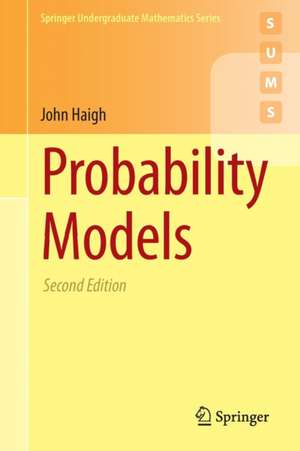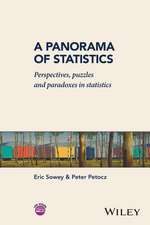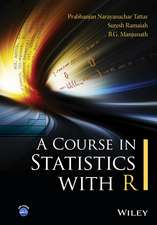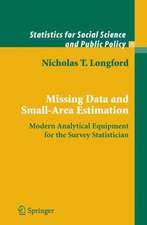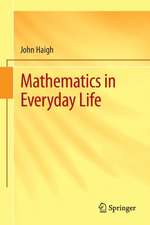Probability Models: Springer Undergraduate Mathematics Series
Autor John Haighen Limba Engleză Paperback – 14 iul 2013
Applications include branching processes, random walks, Markov chains, queues, renewal theory, and Brownian motion. This textbook contains many worked examples and several chapters have been updated and expanded for the second edition.
Some mathematical knowledge is assumed. The reader should have the ability to work with unions, intersections and complements of sets; a good facility with calculus, including integration, sequences and series; and appreciation of the logical development of an argument. Probability Modelsis designed to aid students studying probability as part of an undergraduate course on mathematics or mathematics and statistics.
Din seria Springer Undergraduate Mathematics Series
-
 Preț: 350.50 lei
Preț: 350.50 lei -
 Preț: 237.41 lei
Preț: 237.41 lei -
 Preț: 358.82 lei
Preț: 358.82 lei -
 Preț: 237.18 lei
Preț: 237.18 lei -
 Preț: 240.63 lei
Preț: 240.63 lei -
 Preț: 268.37 lei
Preț: 268.37 lei -
 Preț: 224.54 lei
Preț: 224.54 lei -
 Preț: 319.90 lei
Preț: 319.90 lei -
 Preț: 301.10 lei
Preț: 301.10 lei -
 Preț: 236.97 lei
Preț: 236.97 lei -
 Preț: 358.55 lei
Preț: 358.55 lei -
 Preț: 325.20 lei
Preț: 325.20 lei -
 Preț: 221.92 lei
Preț: 221.92 lei -
 Preț: 237.29 lei
Preț: 237.29 lei -
 Preț: 359.15 lei
Preț: 359.15 lei -
 Preț: 265.92 lei
Preț: 265.92 lei -
 Preț: 236.87 lei
Preț: 236.87 lei -
 Preț: 383.17 lei
Preț: 383.17 lei -
 Preț: 229.86 lei
Preț: 229.86 lei -
 Preț: 238.28 lei
Preț: 238.28 lei -
 Preț: 283.11 lei
Preț: 283.11 lei -
 Preț: 239.86 lei
Preț: 239.86 lei -
 Preț: 266.70 lei
Preț: 266.70 lei -
 Preț: 269.99 lei
Preț: 269.99 lei - 15%
 Preț: 526.67 lei
Preț: 526.67 lei -
 Preț: 272.49 lei
Preț: 272.49 lei -
 Preț: 320.20 lei
Preț: 320.20 lei -
 Preț: 265.18 lei
Preț: 265.18 lei -
 Preț: 275.36 lei
Preț: 275.36 lei -
 Preț: 278.24 lei
Preț: 278.24 lei -
 Preț: 272.69 lei
Preț: 272.69 lei -
 Preț: 258.88 lei
Preț: 258.88 lei -
 Preț: 265.83 lei
Preț: 265.83 lei -
 Preț: 266.70 lei
Preț: 266.70 lei -
 Preț: 275.74 lei
Preț: 275.74 lei -
 Preț: 328.08 lei
Preț: 328.08 lei -
 Preț: 265.78 lei
Preț: 265.78 lei -
 Preț: 275.74 lei
Preț: 275.74 lei -
 Preț: 273.45 lei
Preț: 273.45 lei -
 Preț: 277.32 lei
Preț: 277.32 lei -
 Preț: 270.57 lei
Preț: 270.57 lei -
 Preț: 273.63 lei
Preț: 273.63 lei -
 Preț: 265.36 lei
Preț: 265.36 lei -
 Preț: 265.36 lei
Preț: 265.36 lei -
 Preț: 268.08 lei
Preț: 268.08 lei -
 Preț: 272.86 lei
Preț: 272.86 lei -
 Preț: 272.69 lei
Preț: 272.69 lei -
 Preț: 271.16 lei
Preț: 271.16 lei -
 Preț: 270.74 lei
Preț: 270.74 lei
Preț: 270.19 lei
Nou
Puncte Express: 405
Preț estimativ în valută:
51.71€ • 53.78$ • 42.69£
51.71€ • 53.78$ • 42.69£
Carte tipărită la comandă
Livrare economică 14-28 aprilie
Preluare comenzi: 021 569.72.76
Specificații
ISBN-13: 9781447153429
ISBN-10: 1447153421
Pagini: 300
Ilustrații: XII, 287 p. 17 illus.
Dimensiuni: 155 x 235 x 23 mm
Greutate: 0.42 kg
Ediția:2nd ed. 2013
Editura: SPRINGER LONDON
Colecția Springer
Seria Springer Undergraduate Mathematics Series
Locul publicării:London, United Kingdom
ISBN-10: 1447153421
Pagini: 300
Ilustrații: XII, 287 p. 17 illus.
Dimensiuni: 155 x 235 x 23 mm
Greutate: 0.42 kg
Ediția:2nd ed. 2013
Editura: SPRINGER LONDON
Colecția Springer
Seria Springer Undergraduate Mathematics Series
Locul publicării:London, United Kingdom
Public țintă
Lower undergraduateCuprins
Probability Spaces.- Conditional Probability and Independence.- Common Probability Distributions.- Random Variables.- Sums of Random Variables.- Convergence and Limit Theorems.- Stochastic Processes in Discrete Time.- Stochastic Processes in Continuous Time.- Appendix: Common Distributions and Mathematical Facts.
Recenzii
From the reviews of the second edition:
“It should be on the desk of any university teacher and anybody studying probability and stochastic processes. … there are exercises given in the end of each chapter. Solutions or good hints are summarised and located at the end of the book. All these make the book more than useful to a wide spectrum of readers. For anybody needing a good introduction to modern probability and stochastic processes, this is the book to start with.” (Jordan M. Stoyanov, zbMATH, Vol. 1286, 2014)
“This is an introductory book on probabilistic modeling that I can recommend to any student or teacher. It is not only for probability courses, but also for general mathematics, since the proofs, definitions, and examples are so beautifully intermingled and interspersed.” (Arturo Ortiz-Tapia, Computing Reviews, November, 2013)
“It should be on the desk of any university teacher and anybody studying probability and stochastic processes. … there are exercises given in the end of each chapter. Solutions or good hints are summarised and located at the end of the book. All these make the book more than useful to a wide spectrum of readers. For anybody needing a good introduction to modern probability and stochastic processes, this is the book to start with.” (Jordan M. Stoyanov, zbMATH, Vol. 1286, 2014)
“This is an introductory book on probabilistic modeling that I can recommend to any student or teacher. It is not only for probability courses, but also for general mathematics, since the proofs, definitions, and examples are so beautifully intermingled and interspersed.” (Arturo Ortiz-Tapia, Computing Reviews, November, 2013)
Textul de pe ultima copertă
The purpose of this book is to provide a sound introduction to the study of real-world phenomena that possess random variation. It describes how to set up and analyse models of real-life phenomena that involve elements of chance. Motivation comes from everyday experiences of probability, such as that of a dice or cards, the idea of fairness in games of chance, and the random ways in which, say, birthdays are shared or particular events arise.
Applications include branching processes, random walks, Markov chains, queues, renewal theory, and Brownian motion. This popular second edition textbook contains many worked examples and several chapters have been updated and expanded.
Some mathematical knowledge is assumed. The reader should have the ability to work with unions, intersections and complements of sets; a good facility with calculus, including integration, sequences and series; and appreciation of the logical development of an argument.
Probability Models
Applications include branching processes, random walks, Markov chains, queues, renewal theory, and Brownian motion. This popular second edition textbook contains many worked examples and several chapters have been updated and expanded.
Some mathematical knowledge is assumed. The reader should have the ability to work with unions, intersections and complements of sets; a good facility with calculus, including integration, sequences and series; and appreciation of the logical development of an argument.
Probability Models
Caracteristici
Very suitable for self-study Provides many worked examples and exercises Suitable for beginners; no prior knowledge of probability is needed Includes supplementary material: sn.pub/extras
